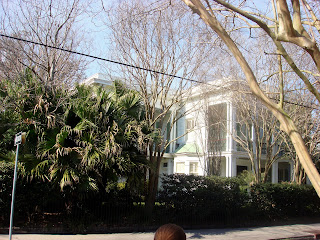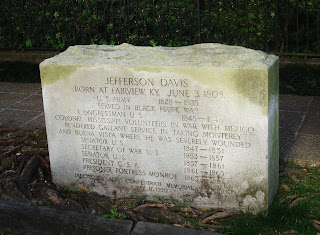NOLA by car
This Blog is primarily a photoblog documenting what I see when I drive around in New Orleans. My photography consists of both 'photography as art' and photography of art.' My focus here is primarily the latter; there is so much to see and show in New Orleans that I don't get around to taking that many artsy pictures.
Saturday, June 14, 2014
Wednesday, January 26, 2011
Wednesday, July 14, 2010
Monday, March 8, 2010
This house is too big to show through regular photography.





Built between 1859 and 1865 by architect Henry Howard for tobacco grower and merchant Walter Robinson, this house, at 1415 Third St., is one of the Garden District's most striking and unusual homes. Walk past the house to appreciate its scale -- the outbuildings, visible from the front, are actually connected to the side of the main house. The entire roof is a large vat that once collected water and acted as a cistern. Gravity provided water pressure and the Garden District's earliest indoor plumbing.
John Goodman's Current / Trent Reznor's Old House

Joseph Merrick Jones House
This house, at 2425 Coliseum St., was the home of Nine Inch Nails singer Trent Reznor. When he moved in, more anti-noise ordinances began being introduced into city council proceedings. Could it be a coincidence that his next-door neighbor was City Councilwoman Peggy Wilson? The house is now the home of actor John Goodman.


More Walking Tour of the Garden District

1137 Second St.
This house is an example of the type of Victorian architecture popularized in uptown New Orleans toward the end of the 19th century. Many who built such homes were from the Northeast and left New Orleans in the summer; otherwise, it would be odd to see this kind of claustrophobic house, normally intended for cool climates, in New Orleans. Note the exquisite stained glass and rounded railing on the gallery.

Payne-Strachan House
Jefferson Davis, president of the Confederate States of America, died at this house at 1134 First St. Davis fell ill while traveling and was taken here, the home of his friend Judge Charles Fenner (son-in-law of owner Jacob Payne). A stone marker in front of the house bears the date of Davis's death, December 6, 1889. (Davis was buried in magnificent Metairie Cemetery for 2 years and then was disinterred and moved to Virginia.)



Brevard-Mahat-Rice House
Designed in 1857 as a Greek Revival town house and later augmented with an Italianate bay, this house, at 1239 First St., is a fine example of "transitional" architecture. It was historically called Rosegate for the rosette pattern on the fence. (The fence's woven diamond pattern is believed to be the precursor to the chain-link fence.) This was the home of novelist Anne Rice and the setting for her Witching Hour novels.
More Garden district walking tour

Pritchard-Pigott House
This Greek Revival double-galleried town house is located at 1407 First St. As fortunes compounded, the typical Garden District house size grew. Americans introduced two house forms: the cottage (as in Toby's Corner) and the grander town house (seen here).

Archie Manning House
This house, at 1420 First St., is the home of former New Orleans Saints superstar quarterback Archie Manning and the childhood home of his sons, who football fans may have heard something about as well: Peyton, the quarterback for the Indianapolis Colts; and Eli, the quarterback for the New York Giants.


Bradish Johnson House and Louise S. McGehee School
Paris-trained architect James Freret designed this French Second Empire-style mansion at 2343 Prytania St., which was built for sugar factor Bradish Johnson in 1872 at a cost of $100,000 (that's more than $1.6 million today). Contrast this house's awesome detail with the stark classical simplicity of Toby's Corner across the street -- a visual indication of the effect that one generation of outrageous fortune had on Garden District architecture. Since 1929 the building has been the private Louise S. McGehee School for girls.

Women's Opera Guild House
Some of the Garden District's most memorable homes incorporate more than one style. Designed by William Freret in 1858, this building, at 2504 Prytania St., combines Greek Revival and Queen Anne styles. Now owned by the Women's Opera Guild, the home can be toured by special arrangement (tel. 504/899-1945) starting in April 2009.
Garden District walking tour

Our Mother of Perpetual Help Chapel
Once an active Catholic chapel, this site, at 2523 Prytania St., was owned by Anne Rice, as was the Marigny-Claiborne House (built for the daughter-in-law of Bernard Marigny) on the other side of the block at 2524 St. Charles Ave. It's the setting for her novel Violin. The former chapel is now owned by actor Nicolas Cage. The author's childhood home is down the street at 2301 St. Charles Ave.

Briggs-Staub House
Located at 2605 Prytania St., this is the Garden District's only example of Gothic Revival architecture. Because this style reminded the Protestant Americans of the Roman Catholicism of their Creole antagonists, it did not become popular. Original owner Charles Briggs did not hold African slaves but did employ Irish servants, for whom he built the relatively large adjacent servant quarters. Irish immigration was then starting to create the Irish Channel neighborhood across Magazine Street from the Garden District.
Colonel Short's Villa
This house, at 1448 Fourth St., was built by architect Henry Howard for Kentucky Colonel Robert Short. The story goes that Short's wife complained of missing the cornfields in her native Iowa, so he bought her the cornstalk fence. A revisionist explanation supplied by a recent owner is that the wife saw that it was the most expensive fence in the building catalog and requested it. Second Civil War occupational governor Nathaniel Banks was quartered here.


A hedge maze in the FQ







